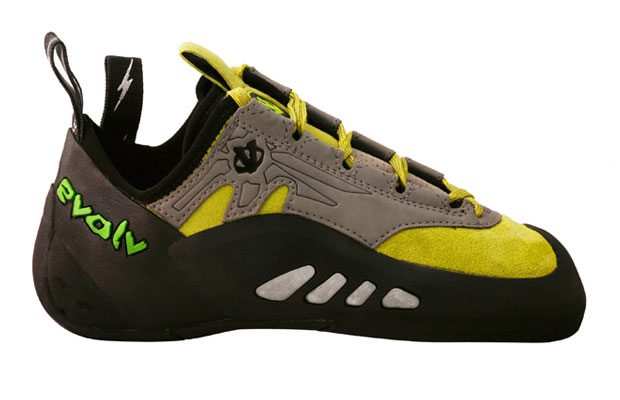Update: Evolv Geshido
Sizes: 4–13.5 U.S. men’s (including half sizes)
Profile: Asymmetric down-cambered
Upper: Leather forefoot and synthetic heel
Lining: Microfiber forefoot, leather footbed, cotton heel
Midsole: MX-P: 1mm half-length concave midsole
Sole: 4.2mm TRAX® high friction rubber
Rand: VTR rand (thicker front toe area)
Weight: 9.5 oz (half pair, size 9 men’s)
My Foot: Average shape, medium arch, but small
Street Shoe Size: 5-5.5
Size Tested: 5.5
MSRP: $139
Days Tested: 20
Test Locations: Red Rocks, Nevada; South Platte and Shelf Road, Colorado
Update
My initial review of the Evolv Geshido focused on its fit, and its performance on plastic. I’ve now had time in the Geshido outside, and I’ve been pleasantly surprised.
After climbing indoors, my overall impressions of the shoes were:
- That they were very comfortable for the level of high-angle performance that they provide.
- That the toe and edge areas felt oddly bulky, but still provided strong performance despite the lack of sensitivity.
- The “love bump” comfortably increases edging power.
And after testing these shoes on both sandstone and polished granite, my initial impressions were largely confirmed.
My greatest hesitation with these shoes was the unusual feeling of the VTR 3D system, because the toe area of the shoe always feels just a little bit awkward at the very beginning of the climb.
Evolv designed these shoes with additional rubber in areas of high wear, which gives the toe of the shoe a slightly bulky feel. However, unlike the La Sportiva TC Pro or Mythos, the sole is not particularly thick by any means. Thus, the Geshido feels a bit awkward here because it combines a moderately stiff sole with an uneven rubber distribution, which is a fairly unusual combination.
And yet, overall, I think this is an advantageous combination. For being such a high-performance shoe, the “Love Bump” and VTR design features really make this a comfortable shoe as well—something I especially appreciated on long outdoor routes, and especially so on slabby climbs.
Slabs
Originally, I did not expect the Geshido to perform well on slab routes because of its technical, down-turned design. Turns out, however, that it excels at edging, and this combined with the fact that they are so comfortable worked well on slabs after all.
The Geshido’s thick toe area decreases the sensitivity right under the toes. Unlike the Five-Ten Anasazi LV, I could not feel every micro crystal that I was stepping on, and had to make an effort to look down at my feet more often. But I think that the Geshido actually stuck slightly better than the Anasazi to polished, tiny, and smeary holds. Once I got over an initial lack of trust, I felt much more solid on marginal foot chips in the South Platte than I had in the Anasazi.
Overall Performance
Like the Five-Ten Anasazi, and the La Sportiva Katana, the Geshido is a versatile, broad-ranging shoe. Outside, I found them to excel on technical, foot-intensive, vertical and overhanging walls. I was particularly impressed on a recent trip to Shelf Road, where the Geshidos easily toed in on the multitude of tiny, oddly-shaped and slick pockets.

Although the sensitivity in the very toe region of these shoes is markedly less than the Anasazi or Five-Ten Blackwing, the edging and toeing abilities are far improved. The Geshidos easily stuck to the tiniest of micro chips, and I was pleasantly surprised by how well they handled the Shelf’s slippery limestone.
They also performed quite well on steep overhangs and roof climbs in the gym, and, to my surprise, they stormed through delicate slabs without much effort.
Trad Climbing
As far as traditional climbing goes, I found the Geshido to be a slightly more generalist equivalent to the La Sportiva Miura lace-ups. They perform well in cracks and on long routes, but are not designed as specifically for that setting as a full-on trad shoe.
On a spectrum of pure comfort on the one end and pure performance on the other, they lean a bit closer to the performance end than many other comfortable trad shoes, but don’t combine comfort with performance as seamlessly as the La Sportiva TC Pro.
Notes on Sizing
The Geshido stretched only a tiny bit for me. I would not recommend downsizing these shoes, because a large tenet of their strong performance is how comfortable they are straight out of the box.
My right foot is somewhat larger than my left, and in this case, the right Geshido fit more tightly. However, the left Geshido performed equally as well as the right, and was significantly more comfortable. I seriously doubt that heavy downsizing would increase performance at any appreciable level.
Details: Geshido’s Lacing System & Tongue Design
The Geshidos’ lacing system is incredibly simple, unlike many other shoes. Should a lace rip or snap, it wouldn’t take eons to relace, like the La Sportiva Mythos or other shoes.
The tongue of the shoe is also well designed. It is only attached to the shoe near the toe box, so if you loosen up the laces all the way, you can slide in your foot much more easily than many other pairs, which helps alleviate some foot pain and provides a more dialed fit.
Bottom Line
The Geshido is an excellent, high-performance, all-around shoe. They are quite comfortable for the level of performance that they provide, and they provide peace of mind in nearly all types of terrain.
However, as with every other generalist shoe out there, they won’t blow any specialist shoe out of the water in a specific discipline. So if you are looking for one shoe specifically to master overhangs, or to hold up for weeks on end on rolling granite domes, look to a specialist shoe instead.
The Geshido is a better match for climbers who can’t stop trying new types of rock, and for those looking to broaden their skill sets without having to deal with crammed and painful toes.

